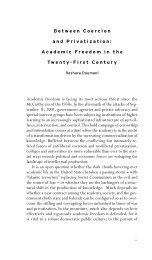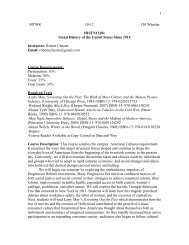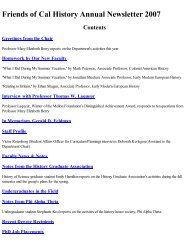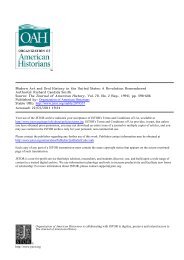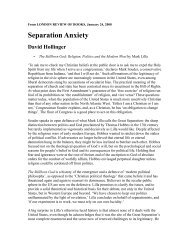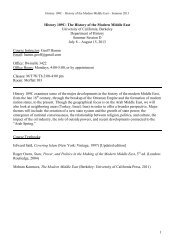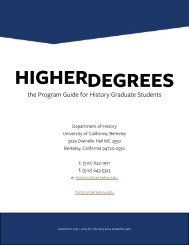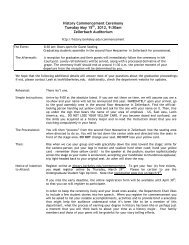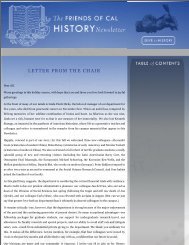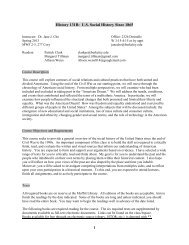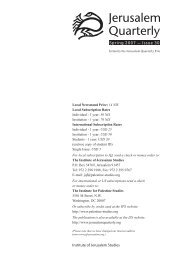David A. Hollinger | Amalgamation and Hypodescent: The Question ...
David A. Hollinger | Amalgamation and Hypodescent: The Question ...
David A. Hollinger | Amalgamation and Hypodescent: The Question ...
Create successful ePaper yourself
Turn your PDF publications into a flip-book with our unique Google optimized e-Paper software.
42 Ê <strong>The</strong> movement for reparations for Japanese-American internees came to climax in 1988 with the passage of the Civil LibertiesAct (also known as the Japanese American Redress Bill), which authorized a payment of $20,000 to each victim of internment.Although this figure did not come close to compensating the interned persons for the amount of property loss suffered by many ofthem, it was an important symbolic gesture.43 Ê Reynolds Farley, "Racial Issues: Recent Trends in Residential Patterns <strong>and</strong> Intermarriage," in Neil Smelser <strong>and</strong> JeffreyAlex<strong>and</strong>er, eds., Diversity <strong>and</strong> Its Discontents (Princeton, N.J., 1999), 126. See also Roberto Suro, "Mixed Doubles," AmericanDemographics (November 1999): 56–62.44 Ê For a far-ranging discussion of out-marriage by Asian Americans, see Frank Wu, Yellow: Race in America beyond Black <strong>and</strong>White (New York, 2002), 261–300.45 Ê Gary Nash, "Toward a Recognition of Mestizo America," Journal of American History 82 (December 1995): 941–62.46 Ê Pascoe, "Miscegenation Law," 51–52.47 Ê For accounts of Perez's suit <strong>and</strong> of press attention to it, see Mark Robert Brilliant, "Color Lines: Civil Rights Struggles onAmerica's 'Racial Frontier,' 1945–1975" (PhD dissertation, Stanford University, 2002), 129; <strong>and</strong> Dara Orenstein, "Between theLines: Mexicans, Miscegenation, <strong>and</strong> Perez v. Sharp," unpublished paper, 2002.48 ÊPerez v. Sharp, 32 Cal. 2d 711, 198 P.2d 17.49 Ê Neil Foley, <strong>The</strong> White Scourge: Mexicans, Blacks, <strong>and</strong> Poor Whites in Texas Cotton Culture (Berkeley, Calif., 1997), 208, 211.See also Foley, "Becoming Hispanic: Mexican Americans <strong>and</strong> the Faustian Pact with Whiteness," in Foley, ed., Reflexiones: NewDirections in Mexican American Studies (Austin, Tex., 1998), 53–70.50 Ê For the South Asian <strong>and</strong> Latino mixture, see Karen Isaksen Leonard, Making Ethnic Choices: California's Punjabi MexicanAmericans (Philadelphia, 1992). A helpful discussion of the Supreme Court's 1923 ruling in U.S. v. Thind that South Asians werenon-white can be found in Ian Haney Lopez, White by Law: <strong>The</strong> Legal Construction of Race (New York, 1996), 86–92. Californiaofficials were not always clear whether ethnic Filipinos were covered by the "Mongolian" provision of that state's antimiscegenationstatute. Decisions were made on a county-to-county basis until 1933, when the state's supreme court, responding to asuit brought by a Filipino American protesting the refusal of the Los Angeles County clerk's office to issue him a marriage license tomarry a white woman, ruled that Filipinos were not covered. <strong>The</strong> legislature promptly added "Malay" to the statute. For California<strong>and</strong> Filipino Americans, see Leti Volpp, "American Mestizo: Filipinos <strong>and</strong> Anti-Miscegenation Laws in California," University ofCalifornia Davis Law Review 33 (2000), rpt. in Johnson, Mixed Race, 86–93.51 Ê A convenient listing of the Census Bureau's shifting categories from decade to decade is provided as an appendix to MelissaNobles, Shades of Citizenship: Race <strong>and</strong> the Census in Modern Politics (Stanford, Calif., 2000), 187–90. For a probing discussion ofthe role of "blackness" within Latino political solidarities, see Silvio Torres-Saillant, "Problematic Paradigms: Racial Diversity <strong>and</strong>Corporate Identity in the Latino Community," in Marcelo M. Suarez-Orozco <strong>and</strong> Mariela M. Paez, eds., Latinos Remaking America(Berkeley, Calif., 2002), 435–55.52 Ê For a new study of the politics of the immigration restriction legislation of 1924, see M. M. Ngai, "<strong>The</strong> Architecture of Race inAmerican Immigration Law," Journal of American History 86 (1999): 67–92.53 Ê For an exceptionally clear <strong>and</strong> well-informed discussion of the census categories <strong>and</strong> their relation to ethnoracial mixture,including a review of the specific issue of how to deal with Latinos, see Joel Perlmann, Reflecting the Changing Face of America:Multiracials, Racial Classification, <strong>and</strong> American Intermarriage (Ann<strong>and</strong>ale-on-Hudson, N.Y., 1997).54 Ê For an up-to-date, critical overview of the scientific utility of the concept of "race," see Joseph L. Graves, Jr., <strong>The</strong> Emperor'sNew Clothes: Biological <strong>The</strong>ories of Race at the Millennium (New Brunswick, N.J., 2001). See also the pointed interventions ofJames F. Crow <strong>and</strong> Ernest Mayr, in Daedalus (Winter 2002): 81–88 <strong>and</strong> 89–94, <strong>and</strong> by Bruce Wallace in the Spring 2002 issue(144–46) of the same journal. Although the characterization of race as a "social construction" rather than a biological reality has beena mantra in recent decades for people who defend the continued use of "race," a difficulty is that the term long maintained itscurrency in the English language as a way of denoting exactly those features of a human being that cannot be changed by socialconditions, as in the saying, "<strong>The</strong> leopard cannot change its spots" (which derives from an ancient commentary on skin color,Jeremiah 13: 23, which reads: "Can the Ethiopian change his skin or the Leopard his spots?"). Hence a term with an imposing



